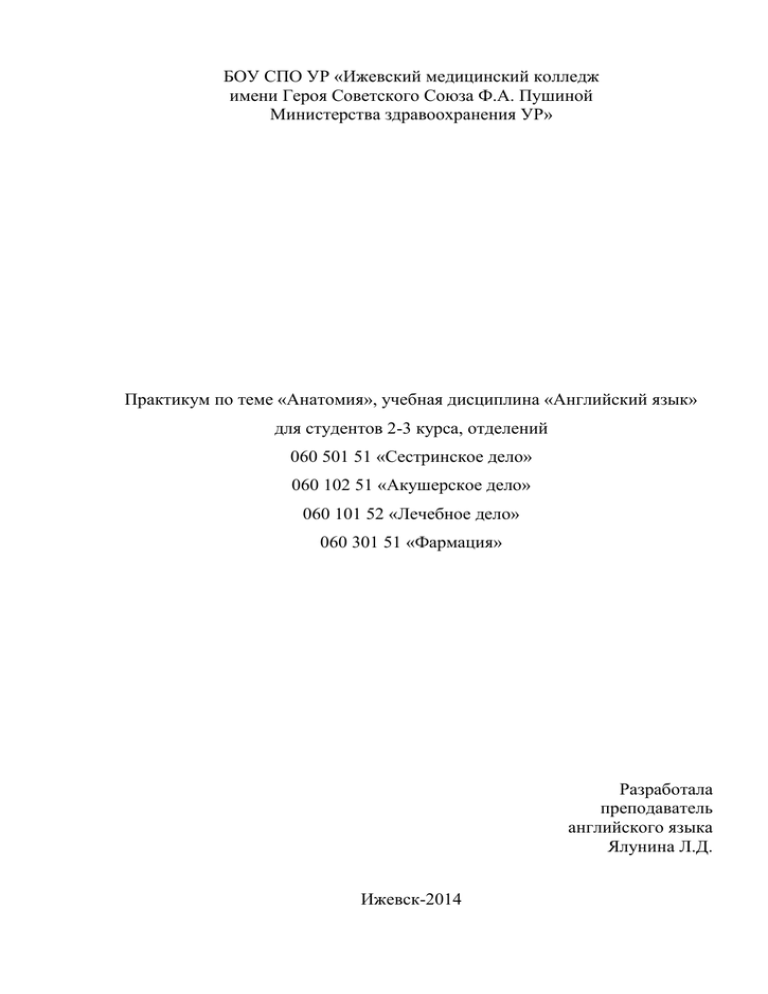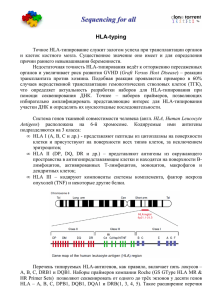Анатомия», учебная дисциплина «Английский язык».
реклама

БОУ СПО УР «Ижевский медицинский колледж имени Героя Советского Союза Ф.А. Пушиной Министерства здравоохранения УР» Практикум по теме «Анатомия», учебная дисциплина «Английский язык» для студентов 2-3 курса, отделений 060 501 51 «Сестринское дело» 060 102 51 «Акушерское дело» 060 101 52 «Лечебное дело» 060 301 51 «Фармация» Разработала преподаватель английского языка Ялунина Л.Д. Ижевск-2014 Пояснительная записка Как сказал Гиппократ: «Изучение тела человека - первооснова изучения медицины», поэтому одной из основных учебных дисциплин при подготовке медицинских работников является «Анатомия тела человека», в том числе и средствами иностранного языка, основной целью данного практикума является введение и закрепление лексико - фразеологического минимума по теме «Анатомия». Совершенствование знаний грамматики английского языка по теме видо - временной формы глагола Present Simple, совершенствование знаний студентов во всех видах речевой деятельности с упором на коммуникативный аспект, а также укрепление мотивации самостоятельного изучения студентами иностранного языка. 2 Уровни усвоения (ожидаемый результат) Студент должен уметь: -активно использовать изученную лексику в монологической и диалогической речи, правильно пользуясь грамматическими формами -правильно писать термины, относящиеся к лексико-фразеологическому минимуму -воспринимать на слух «живую» речь по пройденной теме Студент должен знать: -лексико - фразеологический минимум по теме -видовременную форму глагола Present Simple Интегративные связи Межпредметные: -Анатомия и физиология человека Внутрипредметные: -«Грамматика английского языка» -«Метод создания авторского текста - как здоровье сберегающая технология на уроке английского языка» 3 Anatomy I Прочитайте слова 1. head - голова 2. trunk-туловище 3. limb-конечность, член (тело) 4. forehead-лоб 5. mouth - рот 6. tongue - язык 7. palate-неба 8. gum-десна 9. tooth - зуб 10. to breathe - дышать 11. stomach - желудок 12. liver - печень 13. spleen - селезенка 14. kidney - почка 15. gall-bladder-желчный пузырь 16. bladder-мочевой пузырь 17. shoulder- плечо 18. forearm - рука 19. wrist - запястье 20. hand - рука 21. finger- палец 22. thumb - большой палец 23. hip - бедро 24. thigh - бедро 25. knee - колено 26. chin - подбородок 27. leg- нога 28. calf- икра (нога) 29. ankle - лодыжка 30. foot- нога 31. human body - человеческое тело 32. tо consist of - состоять из 33. upper- верх 34. lower- низ 35. skull- череп 4 36. tо contain - содержать 37. brain -мозг 38. lip- губа 39. cheek- щека 40. external - внешний 41. internal - внутренний 42. to connect - соединять 43. neck- шея 44. chest- грудная клетка 45. abdomen - брюшная полость 46. lung- легкая 47. heart- сердце 48. gullet- глотка 49. beat- биение 50. abdominal - брюшной 51. cavity - полость 52. bone- кость 53. skeleton - скелет 54. tо support- поддерживать 55. soft- мягкий 56. tо protect - предохранять 57. injury- рана, ушиб, ранение 58. muscle- мускул 59. framework - диафрагма II Прочитайте и поймите содержание текста At the practical Anatomy class we study the human body. The principle parts of the human body are the head, the trunk and the limbs (extremities). We speak of the upper extremities (arms) and the lower extremities (legs). The head consists of two parts: the skull which contains the brain, and the face which consists of the forehead, the eyes, the nose, the mouth, the cheeks, the ears and the chin. In the mouth there are gums with teeth, the tongue and the palate. The head is connected with the trunk by the neck. The upper part of the trunk is the chest and the lower one is the abdomen. The principle organs in the chest are the lungs, the heart and the gullet (esophagus). We breathe with the lungs. The heart contracts and makes 60-80 beats per minute. The principle organs in the abdominal cavity are the stomach, the liver, the spleen, the intestine, the kidneys, the gall-bladder and the bladder. The framework of the bones is called the skeleton; it supports the 5 soft parts and protects the organs form injury. The bones are covered with muscles. The upper extremity is connected with the chest by the shoulder. Each arm consists of the upper arm, forearm, elbow, wrist and hand. We have four fingers and a thumb on each hand. The lower extremity (the leg) consists of the hip (the thigh), knee, calf, ankle and foot. The body is covered by the skin. III Пользуясь текстом, вставьте пропущенные слова 1. The principal parts of the human body are...,.... 2. An upper limb (extremity) consists of ...,.... 3. A neck connects ... with .... 4. The heart... and makes about 60 - 80 ... per minute. 5. The upper extremity is connected to the ... with the .... 6. The head consists of the ... and the .... 7. The principal organs in the abdominal cavity are ...,.... 8. ... supports and protects the organs from injury. 9. The skull contains ... . 10. The mouth has .... 11. The human face consists of the ...,...,.... 12. The human body is covered with ... . 13. The frame work of bones is called .... 14. The bones are covered with .... 15. The upper part of the ... is the ... . 16. The lower part of part of the ... is the .... 17. In the mouth there are ...,...,.... 18. The ear includes ..., ..., .... 19. The skeleton ... and ... the ... from injury. 20. ... are covered with muscles. 21. Each arm consists of the ...,... . 22. The lower extremity consist of the ...,.... 23.... is called the skeleton. 24. The principal organs in the abdominal cavity are ..., ... . 25. ... is covered with the skin. 26. The heart... and ... about 60 - 80 ... per minute. 6 IV Из данных слов составьте предложения, помните, в предложении на английском языке на I месте стоит подлежащее, на II сказуемое, на III дополнение, на IV обстоятельство. Students study Anatomy at the Medical College 1. body, the, human study, we, anatomy, in. 2. limbs (extremities), the, parts, are, the, head, trunk, parts, body, human, are, of, principal, the. 3. Upper, lower, are, there, and, extremities, arms, legs, and. 4. Head, the ,two, consists, of, parts, skull, face, and, the. 5. Contains, brain, the, skull, the. 6. of, forehead, the, face, eyes, consists, the nose, mouth, lips, with, and lower, upper, cheeks, and chin the, ears. 7. ear, external, the, middle, internal, the, includes parts, principal, three, the ear, and. 8. a, and, palate, tongue, a teeth, gums, are, mouth, the, in, three. 9. neck, trunk, the, to, with, is, the, head, connected. 10. chest, the, is, trunk, the, of, part, upper, the. 11. organs, the, in, chest, principal, the, heart, lungs, the, gullet (esophagus), the, are. 12. bladder, the, gall-bladder, kidneys, intestines, spleen, liver, are, stomach, principal, the, in, cavity, abdominal, organs. 13. skeleton, called, the, bones, of, framework, the, is. 14. supports, protects, and, parts, soft, organs, injury, from, skeleton, the, and. 15. muscles, covered, are, with, bones, the. 16. the, shoulder, to, chest, the, with, connected, extremity, is, upper, the. 17. the, of, arm, upper, forearm, elbow, wrist, hand, the and, consists, the. 18. hand, each, on, thumb, and, a, fingers, four, have, we. 19 .the foot, and, ankle, the, calf, knee, the, hip, the, consists, of, the(leg), lower, extremity. 20. skin, with, body, the, covered, is. 7 V. Изучите обозначение и образование Present Simple и переведите следующие вопросы с русского языка на английский Present Simple (Настоящее простое) Обозначает действие, которое происходит ВООП ( всегда, вообще, обычно, постоянно) +V (3 л. ед ч) +S -? Do -? Does (3 л. ед ч) + 1 give ingections. You give ingections. He She gives ingections. It We give ingections. They give ingections always, usually, often, sometimes, seldom, everyday, - I don't (do not) give ingections. You don't give ingections. He She doesn't (does not) give ingections. It We don't give ingections. They don't give ingections. ? Do I give ingections? Do you give ingections? He Does she give ingections? It Do we give ingections? Do they give ingections? Yes I do No I don't Yes you do No you don't He He Yes she does No she doesn't It It Yes we do No we don't Yes they do No they don't Если в предложении содержится глагол to be (am, is, are) в вопросительном предложении глагол to be ставится перед подлежащим. VI. Представьте, что вы готовитесь к зачету по теме «Анатомия», обсудите тему с собеседником в диалогической речи, обменявшись вопросами и начертив схему структурной организации тела человека 1. Каковы основные части человека? 2. Каково строение головы? 3. Что содержит череп? 4. Из каких частей состоит лицо человека? 5. Каково строение рта человека? 6. Является ли грудная клетка верхней частью туловища? 8 7. Каковы основные органы грудной клетки? 8. Каковы основные органы брюшной полости? 9. Чему служит скелет? 10. Каково строение верхней конечности? 11. Каково строение нижней конечности? 12. Чем покрыто тело человека? 1. What are particular parts of the human body? 2. What parts does the head consist of? 3. What does the skull contain? 4. What are there on the human's face? 5. What organs are there in the human's mouth? 6. Is the chest the upper part of the trunk 7. What organs are there in the chest? 8. What organs are there in the abdomen? 9. What does the skeleton serve for? 10.What does the upper limb consist of? 11.What does the lower limb consist of? 12.What is the human body covered with? VII. Открыв скобки, поставьте глагол в правильную форму Present Simple. 1. 2. 3. 4. 5. 6. 7. 8. 9. Human body (is, am) of great interest. It (consist, consists) of the head, trunk, limbs, limbs (is, are) upper and lower. The skull and the face the head (include, includes). The heart, lungs and esophagus (are, is) in the chest. The liver, the stomach and the spleen (am, are) in the abdomen. The bladder, Kindeys, intestines (is, are) in the belly. The gall bladder and the diaphragm (am, are) in the belly too. The lower extremity (consists, consist) the hip, Knee, calf. An ankle, foot, five toes (belong, belongs) to a leg too. VIII. По данному выше образцу составьте авторский текст на тему «Анатомия» IX. Пользуясь схемой структурной организации тела человека, подготовьте устное сообщение об анатомии человека 9 Литература: 1. АванесьянцЭ.М. английский язык для старших курсов/ Э.М. Аванесьянц«АНМИ» Москва 1999 2. Мальцева Н.А универсальный справочник по грамматике английского языка/ Н.А.Мальцева. М.: ГЛОССА, 1999 10
